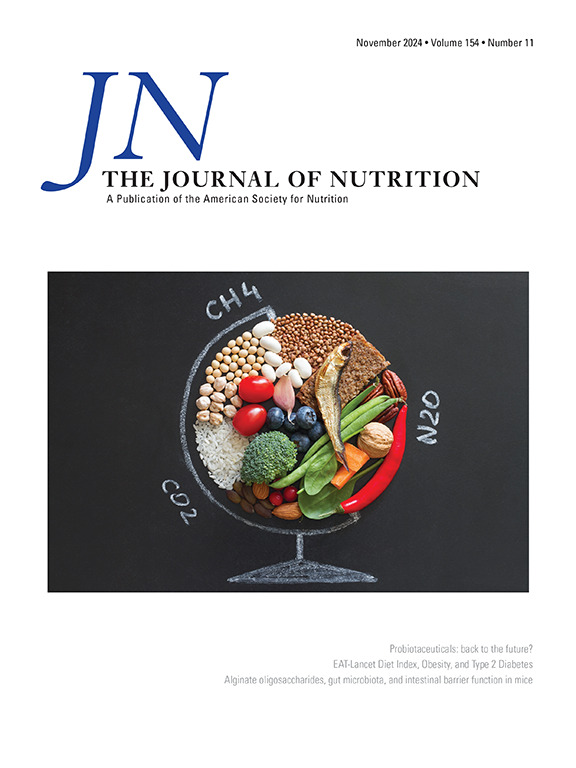25-羟基维生素D3生物强化在不同脂肪水平小鼠蛋黄中的有效性和生物安全性。
IF 3.8
3区 医学
Q2 NUTRITION & DIETETICS
引用次数: 0
摘要
背景:维生素D缺乏仍然是一个公共卫生问题,特别是在肥胖人群中。含有25-羟基维生素D3 [25(OH)D3]的生物强化鸡蛋可能会增加公众对这种营养素的活性代谢物的摄入量。目的:本研究在饲喂对照或高脂肪饮食(HFD)的小鼠中,比较了蛋黄中生物强化的25(OH)D3与合成形式的25(OH)D3的功效、生物安全性和肠道微生物组影响。方法:Reg3b+/-小鼠(雄性4只,雌性4只/组,3-5月龄)饲喂在每千克饲粮中添加200 IU对照蛋黄(BAS) 25(OH)D3、500 IU合成蛋黄(SUP) 25(OH)D3或700 IU生物强化蛋黄(YOL) 25(OH)D3的对照(CON)或HFD(12%或60%卡路里来自脂肪),持续8周。检查体重、25(OH)D3、骨钙素和核因子β受体激活剂配体的血浆浓度、骨显微断层扫描、骨相关基因和蛋白以及结肠和粪便微生物组。数据采用双向方差分析。结果:HFD-YOL组第8周血浆25(OH)D3浓度分别比HFD-SUP组和CON-YOL组高33.4% (P < 0.01)和39.2% (P < 0.001)。这种升高与肾细胞色素P450 24A1 (Cyp24a1)和维生素D受体(Vdr) mRNA水平上调有关。两种来源的25(OH)D3均未改变体重、血糖浓度、血浆碱性磷酸酶活性、血浆骨钙素浓度或骨骼特征,但改变了粪便微生物组成(P < 0.05)。结论:与合成形式相比,生物强化蛋黄中的25(OH)D3导致饲喂HFD小鼠血浆中25(OH)D3浓度升高。然而,两种25(OH)D3来源对CON小鼠的效果和对粪便微生物组的影响是相似的。我们的发现为25(OH)D3这种新型食物来源的未来人类研究提供了生物安全性和营养相关性。本文章由计算机程序翻译,如有差异,请以英文原文为准。
Efficacy and Biosafety of 25-Hydroxyvitamin D3 Biofortified in Egg Yolk in Mice Fed Two Levels of Dietary Fat
Background
Vitamin D inadequacy remains a public health concern, particularly in individuals with obesity. Biofortified eggs with 25-hydroxyvitamin D3 [25(OH)D3] may increase intakes of the active metabolite of this nutrient by the public.
Objectives
This study determined efficacy, biosafety, and gut microbiome impact of 25(OH)D3 biofortified in egg yolk compared with a synthetic form in mice fed a control or high-fat diet (HFD).
Methods
Reg3b+/- mice (n = 4 males + 4 females/group, 3–5 mo old) were fed a control (CON) or HFD (12% or 60% kcal from fat) supplemented (per kg of diet) with 200 international unit (IU) of 25(OH)D3 from the control yolk (BAS), the BAS + 500 IU of 25(OH)D3 from the synthetic form (SUP), or 700 IU of 25(OH)D3 from the biofortified yolk (YOL) for 8 wk. Body weight, plasma concentrations of 25(OH)D3, osteocalcin, and receptor activator of nuclear factor kappa β ligand, bone microtomography, bone-related genes and proteins, and colonic and fecal microbiome were examined. Data were analyzed by 2-way analysis of variance.
Results
The HFD-YOL group had 33.4% (P < 0.01) and 39.2% (P < 0.001) higher plasma 25(OH)D3 concentrations at week 8 than the HFD-SUP and CON-YOL groups, respectively. This elevation was associated with upregulated kidney mRNA levels of cytochrome P450 24A1 (Cyp24a1) and vitamin D receptor (Vdr). Both sources of 25(OH)D3 unaltered body weights, blood glucose concentration, plasma alkaline phosphatase activity, plasma osteocalcin concentrations, or bone characteristics but altered (P < 0.05) fecal microbiome compositions.
Conclusions
Compared with the synthetic form, 25(OH)D3 in the biofortified yolk led to higher plasma 25(OH)D3 concentrations in mice-fed HFD. However, such efficacy in mice fed CON and impacts on fecal microbiome were similar between the 2 sources of 25(OH)D3. Our finding suggests biosafety and nutritional relevance for future human study of this novel food source of 25(OH)D3.
求助全文
通过发布文献求助,成功后即可免费获取论文全文。
去求助
来源期刊

Journal of Nutrition
医学-营养学
CiteScore
7.60
自引率
4.80%
发文量
260
审稿时长
39 days
期刊介绍:
The Journal of Nutrition (JN/J Nutr) publishes peer-reviewed original research papers covering all aspects of experimental nutrition in humans and other animal species; special articles such as reviews and biographies of prominent nutrition scientists; and issues, opinions, and commentaries on controversial issues in nutrition. Supplements are frequently published to provide extended discussion of topics of special interest.
 求助内容:
求助内容: 应助结果提醒方式:
应助结果提醒方式:


